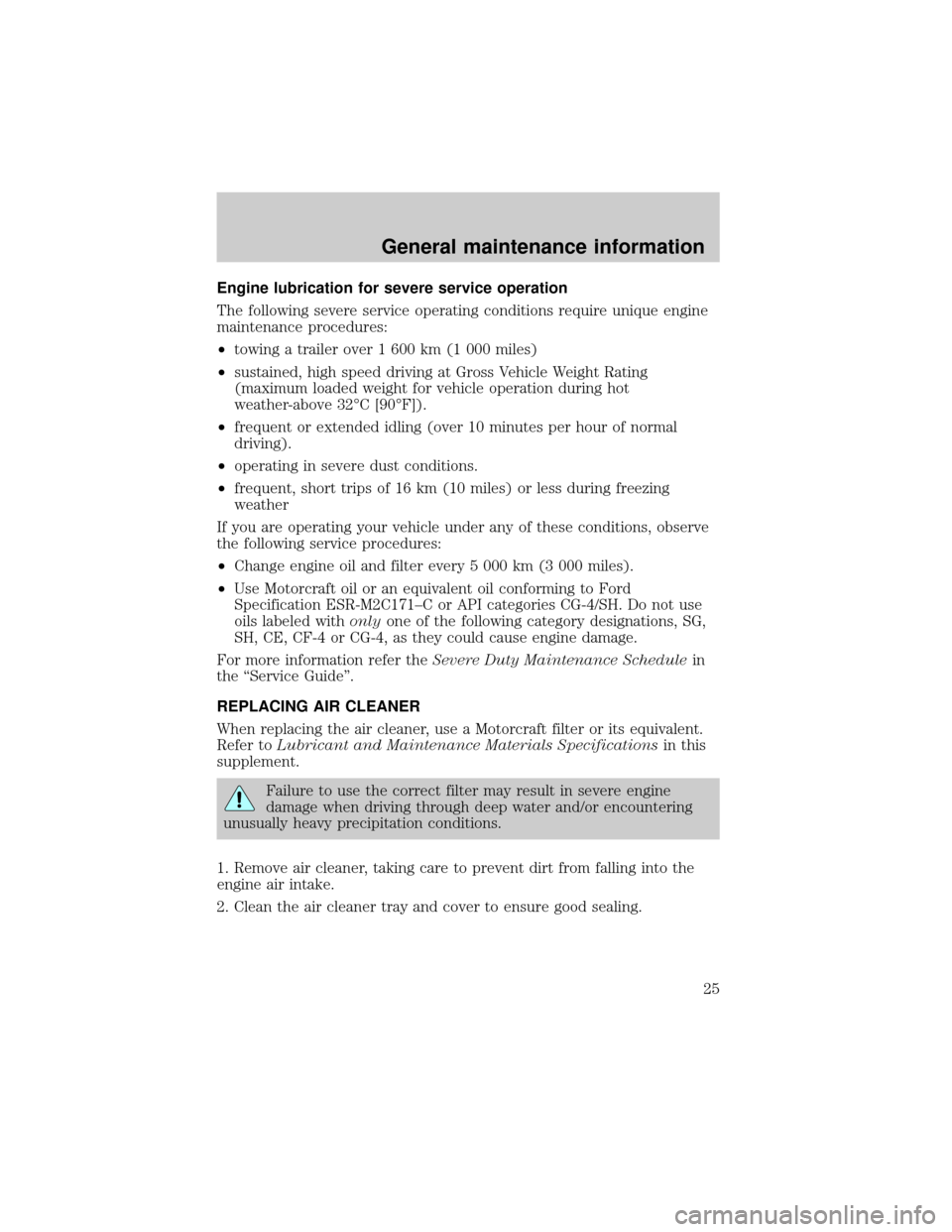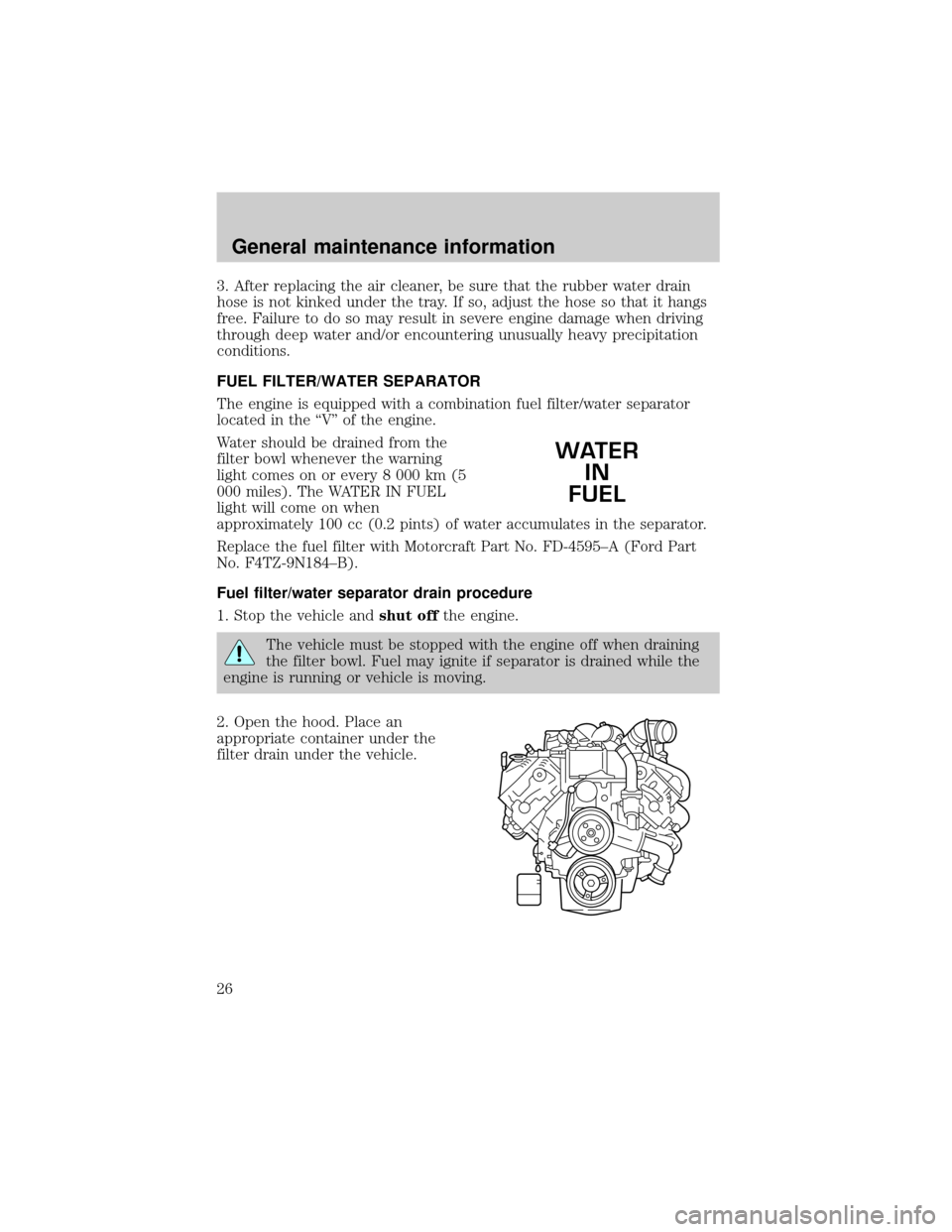Page 20 of 39

Truck stops have pumps and nozzles designed for larger, heavy-duty
trucks. When refueling at truck stops: if the nozzle shuts off repeatedly
when refueling, wait 5±10 seconds; then use a slower rate of flow (don't
depress the nozzle trigger as far).
If air is allowed to enter the fuel system (during fuel filter change or if
you run out of fuel) the engine will purge the trapped air as it runs. The
engine may run rough and produce white smoke while air is in the
system. This is normal and should correct itself in a short time.
An engine that suddenly becomes noisy or operates poorly after a fuel fill
could be using substandard fuel (i.e., high water content, low octane
rating or gasoline in the fuel). Diesel fuel should be purchased from a
reputable station which sells a large amount of diesel fuel.
Care should be taken whenever diesel fuel is stored. Use only clean,
approved containers which will prevent the entry of dirt or water.
Diesel fuel must not be stored in a galvanized container. The fuel will
dissolve the zinc in a galvanized container. The zinc will then remain in
solution until it is run through the engine where it will be deposited in
the fuel injectors causing expensive-to-repair damage.
General maintenance information
20
Page 21 of 39
CHANGING FUEL FILTER
Removal
1. Remove fuel filter cap by turning
counterclockwise. Fuel filter
element will come out with cap.
2. Remove and discard bevel gasket. Carefully clean mating surfaces.
3. Press in on fuel filter element locking tabs, to separate element from
cap.
Installation
The engine will not run properly if the fuel filter is not installed
in housing.
1. Apply a coating of clean diesel fuel to new bevel gasket and install
onto fuel filter housing gland.
2. Install new fuel filter element onto cap. Place new fuel filter element
and cap into fuel filter housing. Allow fuel to soak into fuel filter
element. Tighten cap onto fuel filter housing until cap contacts the
aluminum housing.
Fuel with more than average impurities may require more frequent filter
changing intervals.
General maintenance information
21
Page 22 of 39

After changing the fuel filter, the engine will purge the trapped air as it
runs. Engine may run roughly and smoke until the air is completely
eliminated.
ENGINE OIL
Checking engine oil level
Because it is normal to add some oil between oil changes, check your
engine oil level each time you stop for fuel. To check the engine oil level
consistently and accurately, the following procedure is recommended:
1. Have engine at normal operating temperature (at least into the
NORMAL range on the engine coolant temperature gauge).
2. Park the vehicle on a level surface, then turn off the engine and open
the hood.
4. Allow at least20 minutesafter engine shutdown to assure that the oil
contained in the upper parts of the engine has returned to the oil pan.
5. Protecting yourself from engine
heat, pull out the dipstick, wipe it
clean and reinsert fully.
6. Read oil level on both sides of dipstick and use highest level (reading)
for the actual engine oil level.
7. Maintain the oil level between ADD and OPERATING RANGE on the
dipstick by adding oil as required. The distance from ADD to
OPERATING RANGE on the dipstick represents 1.9L (2 quarts). Do not
overfill. If the oil level exceeds OPERATING RANGE, oil consumption
may result.
General maintenance information
22
Page 23 of 39

Engine oil specifications
To help achieve proper engine performance and durability, it is important
that only engine lubricating oils of the proper quality are used in your
diesel engine and that the engine oil is changedno laterthan the
recommended interval. Diesel engines require specially formulated oil to
resist contamination. Proper quality oils also provide maximum efficiency
of the crankcase ventilating system which reduces air pollution.
For normal or severe service, use Motorcraft oil or an equivalent oil
conforming to Ford Specification WSS-M2C171±C or API Service
categories CG-4/SH. Do not use oil labeled with only one of the following
category designations; SG, SH, CE, CF-4, or CG-4, as they could cause
engine damage.
Engine oils with improved fuel economy properties (energy conserving)
are currently available. If you use an energy conserving oil, be sure it
meets the recommended Ford Specification,APIservice categories and
SAE viscosity grades listed in the Lubricant and Maintenance Materials
Specifications chart. Some energy conserving oilsdo notmeet the
requirements necessary for your diesel engine.
The use of correct oil viscosities for diesel engines is important for
satisfactory operation. Determine which oil viscosity best suits the
temperature range you expect to encounter for the next service interval.
SAE VISCOSITY GRADES
EXPECTED TEMPERATURE RANGE
F˚ -20 -10 0 10 20 30 40
40 35 30 25 20 15 10 5 0 -5 -10 -15 -20 -25 -30 C˚50 60 70 80 90 100
*15W-40 Preferred
10W-30
5W-30
0W-30Preferred
General maintenance information
23
Page 24 of 39

A symbol has been developed by the
American Petroleum Institute (API)
to help you select the proper engine
oil. It will be included on the oil
container you purchase. The top
section of the symbol shows the oil
performance by the API designation.
This should match the owner guide recommendation. The center section
will show the SAE viscosity grade. The lower section will state energy
conserving if the oil has proven fuel saving capabilities.
Changing engine oil and filter
Change your oil and filter according to the ªService Guideº. Change more
frequently if your vehicle operation includes extended periods of idling
or low-speed operation, driving for a long time in cold temperatures or
driving short distances. See the following section ªEngine Lubrication for
Severe Service Operationº for all severe duty restrictions.
Use Ford Engine Oil Filter Part No. F4TZ-6731±A (FL±1995) or
equivalent. These filters protect your engine by filtering harmful,
abrasive or sludge particles. The FL±1995 filters particles significantly
smaller than most available ªwill fitº filters.
To replace, use an oil filter wrench to unscrew the filter from the oil
cooler fitting. Turn it horizontally to let excess oil drain off, and remove.
Do not handle a hot oil filter with bare hands.
Clean the filter mounting area on the oil cooler, lightly coat the gasket
surface of the new filter with clean engine oil and hand tighten until the
gasket contacts the base.Then tighten another 1±1/4 to 2 turns.Fill
the crankcase and run the engine to check for leaks.
Continuous contact with USED motor oil has caused cancer in
laboratory mice. Protect your skin by washing with soap and
water.
APISERVICECG-4/SHSAE15W-40
General maintenance information
24
Page 25 of 39

Engine lubrication for severe service operation
The following severe service operating conditions require unique engine
maintenance procedures:
²towing a trailer over 1 600 km (1 000 miles)
²sustained, high speed driving at Gross Vehicle Weight Rating
(maximum loaded weight for vehicle operation during hot
weather-above 32ÉC [90ÉF]).
²frequent or extended idling (over 10 minutes per hour of normal
driving).
²operating in severe dust conditions.
²frequent, short trips of 16 km (10 miles) or less during freezing
weather
If you are operating your vehicle under any of these conditions, observe
the following service procedures:
²Change engine oil and filter every 5 000 km (3 000 miles).
²Use Motorcraft oil or an equivalent oil conforming to Ford
Specification ESR-M2C171±C or API categories CG-4/SH. Do not use
oils labeled withonlyone of the following category designations, SG,
SH, CE, CF-4 or CG-4, as they could cause engine damage.
For more information refer theSevere Duty Maintenance Schedulein
the ªService Guideº.
REPLACING AIR CLEANER
When replacing the air cleaner, use a Motorcraft filter or its equivalent.
Refer toLubricant and Maintenance Materials Specificationsin this
supplement.
Failure to use the correct filter may result in severe engine
damage when driving through deep water and/or encountering
unusually heavy precipitation conditions.
1. Remove air cleaner, taking care to prevent dirt from falling into the
engine air intake.
2. Clean the air cleaner tray and cover to ensure good sealing.
General maintenance information
25
Page 26 of 39

3. After replacing the air cleaner, be sure that the rubber water drain
hose is not kinked under the tray. If so, adjust the hose so that it hangs
free. Failure to do so may result in severe engine damage when driving
through deep water and/or encountering unusually heavy precipitation
conditions.
FUEL FILTER/WATER SEPARATOR
The engine is equipped with a combination fuel filter/water separator
located in the ªVº of the engine.
Water should be drained from the
filter bowl whenever the warning
light comes on or every 8 000 km (5
000 miles). The WATER IN FUEL
light will come on when
approximately 100 cc (0.2 pints) of water accumulates in the separator.
Replace the fuel filter with Motorcraft Part No. FD-4595±A (Ford Part
No. F4TZ-9N184±B).
Fuel filter/water separator drain procedure
1. Stop the vehicle andshut offthe engine.
The vehicle must be stopped with the engine off when draining
the filter bowl. Fuel may ignite if separator is drained while the
engine is running or vehicle is moving.
2. Open the hood. Place an
appropriate container under the
filter drain under the vehicle.
WATER
IN
FUEL
General maintenance information
26
Page 27 of 39
3.On F-Series models,open filter
drain valve by turning clockwise.
Allow to drain for approximately 25
seconds or until clean fuel is
observed. Close drain valve by
turning counterclockwise until firmly
seated.
3.On Econoline models,open filter drain valve release handle. Allow
to drain for approximately 25 seconds or until clean fuel is observed.
Close drain valve by resetting handle to original position.
4.On all models,verify that the fuel drain is closed. Close the hood and
remove the container from under the vehicle.
5. Restart the engine and check WATER IN FUEL indicator light. The
light should not glow. If it continues to glow, have fuel system checked
and repaired.
DRAIN
CLOSE
General maintenance information
27